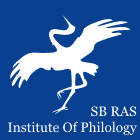 |
|
||||||||||||
|
Institute of Philology of
the Siberian Branch of Russian Academy of Sciences |
|
||||||||||||
|
|||||||||||||
| Sibirskii Filologicheskii Zhurnal (Siberian Journal of Philology) | |
|
Article
Authors: R. T. Muratova Ufa Federal Research Centre RAS, Ufa, Russian Federation In the section Linguistics
Abstract: The paper aims at studying the genesis, evolution, and development of the color terms kük (blue), zäŋgär (sky blue), jäšel (green) in the Bashkir language. The semantics of the terms under study reveals the interesting shifts both in the dialects of the Bashkir language and Turkic languages in general. Bashkir language dictionaries and corpus data of Bashkir prose and folklore have served as sources of examples for identifying the meanings of words. In the literary Bashkir language, the lexeme kük is used to denote “blue,” zäŋgär – “sky blue,” jäšel – “green.” However, there are discrepancies in the meanings of these tokens in the dialects: kük can denote all three colors; zäŋgär – indicates in some dialects only “sky blue,” while in others – “blue”; jäšel means “green” in some dialects and “blue” in others. The lexemes of kük and jäšel go back to the Pre-Turkic words, the word zäŋgär – to Persian. The lexeme kük in the Bashkir language also has retained the pre-Turkic meaning of “grey, gray,” and at the same time, it has a connotative meaning “western” in this language, different from other Turkic languages. Most of the additional meanings of the word jäšel are connected with the fact that originally it was the name of the color of young fresh vegetation, greenery: fresh, young, covered with greenery, not ripe, unripe. Only the word zäŋgär is used to designate only a color – “sky blue” or “blue.” Keywords: Bashkir language, Turkic languages, color terms, blue, sky blue, green Bibliography: Borovkov A. K. Leksika sredneaziatskogo tefsira 12–13 vv. [Vocabulary of the Middle Asian tefsir from 12th–13th centuries]. Мoscow, 1961. Khisamitdinova F. G., Muratova R. T., Yagafarova G. N., Valieva M. R. Tsvetooboznacheniya v bashkirskoy toponimii [Color designations in Bashkir toponymy]. Problems of Onomastics. 2019, no. 1, pp. 140–159. DOI 10.15826/vopr_onom.2019. 16.1.008 Kononov A. N. Semantika tsvetooboznacheniy v tyurkskikh yazykakh [Semantics of color terms in the Türkic languages]. In: Tyurkologicheskiy sbornik – 1975 [Türkological collection – 1975]. Мoscow, 1978, pp. 159–179. Molchanova O. T. Serye, krasnye, sinie, promezhutochnye tsveta v onomastikone nekotorykh tyurkskikh narodov [Color terms for grey, red, blue in Turkic onomastics]. In: Areal’nye issledovaniya po bashkirskoy dialektologii i onomastike Bashkirii [Areal studies of Bashkir dialects and onomastics of Bashkortostan]. Ufa, 1988, pp. 89–103. Muratova R. T. Tsvetooboznachenie һary ‘zheltyy’ v bashkirskom yazyke: genezis, razvitie i leksiko-semanticheskaya kharakteristika [The color term for ‘yellow’ in the Bashkir language: genesis, development and lexical-semantic characteristics]. Ural- Altaic Studies. 2018a, no. 2, pp. 53–70. Muratova R. T. Genezis, razvitie i leksicheskaya semantika tsvetooboznacheniya qythyl ‘krasnyy’ v bashkirskom yazyke [The Bashkir Colour Term Qyźyl (‘Red’): Genesis, Evolution and Lexical Semantics]. Oriental Studies. 2018b, no. 5, pp. 120–131. DOI 10.22162/2619-0990-2018-39-5-120-131 |
 |
Institute of Philology Nikolaeva st., 8, Novosibirsk, 630090, Russian Federation +7-383-330-15-18, ifl@philology.nsc.ru |
© Institute of Philology |


